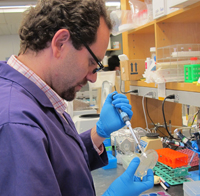Interview with Pew Latin American Fellow Esteban Engel
| "What most people might not know, however, is that HSV-1 can also infect the eye, leading to serious problems like blindness, and can even spread to the brain." |
 |
Esteban Engel, a member of the 2011 class of the Pew Latin American Fellows in the Biomedical Sciences, is conducting postdoctoral research in the laboratory of Lynn Enquist at Princeton University. Pew sat down with him to learn more about the work in neurovirolgy—the study of viruses infecting the nervous system—he has undertaken since moving to the United States from Chile.
Q: What led you to become a scientist?
Esteban Engel: Ever since I was a kid, I questioned everything I saw, and at times overwhelmed my family with my inquisitiveness. I was eager to understand the origin of things and how they worked. In fact, I used to disassemble and attempt to reassemble all kinds of stuff, including stereos, TVs, cars, and computers. I even studied insects up close. So biological sciences seemed to be a natural fit with my curiosity and interests.
Q: What were the difficulties in pursuing a science career in Chile?
Esteban Engel: There is still a big difference in funding and research diversity between Chile and the United States. For example, only a handful of researchers are working in my field—virology—in Chile, and although they are very good and productive, there is a need for a bigger scientific community and more resources.
I was lucky enough to finish my Ph.D. at very good institutions in Chile. Fundación Ciencia y Vida and Andrés Bello University were great in terms of funding and infrastructure. My Ph.D. mentor, Dr. Pablo Valenzuela, gave me plenty of freedom to pursue my research.
Q: What made you decide to apply to Pew's Latin American Fellows Program and seek additional training in the United States?
Esteban Engel: As a graduate student, I was fortunate enough to travel for international meetings and participate in an internship abroad. These experiences convinced me that I had to emigrate at some point in my career to gain insight and expertise in research areas that are not explored in Chile. Living abroad has been a mind-expanding experience not only science-wise, but also in exposing me to different cultures, languages, and diversity.
When I was seeking postdoctoral funding in the United States, I realized that a very limited number of fellowships were available for international researchers. I learned about the Pew fellowship for Latin American scientists from colleagues in Chile. They were impressed with the program, so I knew that I had to apply.
Q: What are you researching in Dr. Enquist's lab?
Esteban Engel: I am currently working with clinical strains of herpes simplex virus type 1, or HSV-1, which is a human pathogen. Most people know HSV-1 as the causative agent of cold sores, which is a rather minor problem. What most people might not know, however, is that HSV-1 can also infect the eye, leading to serious problems like blindness, and can even spread to the brain. Although this rarely happens, it causes severe damage that can lead to lethal encephalitis.
Once the virus reaches the central nervous system, or CNS, it is exceedingly difficult to treat with the drugs currently available. It is not fully understood why the virus usually stays in the peripheral nervous system when the CNS is only one synapse away. HSV-1 efficiently replicates and spreads through synaptically connected neurons in both directions. My goal is to understand the viral and host mechanisms that control such a precise spread. Learning about the way it travels through the nervous system could allow the design of a vaccine or more effective anti-viral drugs. Additionally, many laboratories around the world use the fluorescent versions of the virus we have developed in Dr. Enquist's lab to trace and decipher the hardwiring of the nervous system connections.
Q: What attracted you to your current research?
Esteban Engel: I did my Ph.D. in plant pathology, and for my postdoc I decided I was ready to switch gears and work in something completely new to me. I wanted to learn more about animal virology, so I started to search for laboratories in that field. When I opened the Enquist lab Web page and saw microscopy movies of fluorescent viral particles moving in and between live neurons, that blew my mind! I immediately felt attracted to his laboratory even though I knew nothing about neurons or animal viruses. Lynn Enquist has been a terrific and supportive mentor in the last two years—I could not have chosen any better!
Q: What has it meant to be a Pew Latin American fellow?
Esteban Engel: It's been a world of difference and a huge peace of mind to have my own funds during two years of my postdoc. I feel very fortunate to have such a prestigious fellowship and also to meet very talented colleagues in the annual Pew meetings. The Pew fellowship is well known in Chile. It affords me the funding support to start my own lab when I move back. This is a great deal of help, especially early on, when it is hard to get competitive grants.
Since 1985, Pew's biomedical programs have been supporting promising beginning researchers in the health sciences—particularly young investigators with innovative approaches and ideas. This article is the fourth in a "Biomedical Researcher of the Month" series highlighting Pew's biomedical programs.











